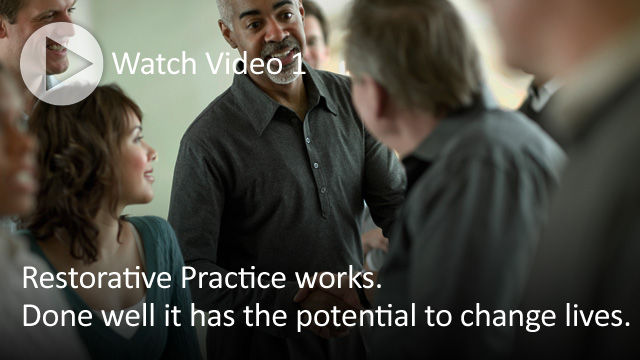The Restorative Service Standards
The Restorative Service Standards describe the minimum requirements needed to provide a safe and effective restorative service. Based on local consultation, they allow for flexibility in local delivery models to meet service users’ needs.
-
01: Leadership
Leaders champion restorative practice, ensuring it is clear how restorative processes support the organisation’s aims and values. Leaders own restorative practice at a senior level and ensure that relevant staff/volunteers understand the value of restorative practice to the organisation and its aims. Leaders ensure that effective systems are in place for delivering restorative practices. Leaders are committed to continually improving the effectiveness of restorative practices and ensure that improvement takes place.
-
02: Strategy, Policies and Plans
Restorative practice is included in the organisation’s overall strategy, business plan and other relevant policies and plans. Policies and plans with regard to restorative practice are based on consultation with stakeholders, the local context and national guidance. They are realistic and deliverable, and have sufficient resources allocated to them. Staff/volunteers understand the restorative practice policies and plans. Progress against plans is regularly assessed and action taken where necessary.
-
03: Working Together
Restorative practice delivery is based on working together effectively with external organisations in order to deliver services properly and achieve the right outcomes for service users. There is also internal collaboration to ensure that restorative practice services are delivered effectively. Access to restorative processes is undertaken effectively and in accordance with a defined procedure.
-
04: People, Training and Support
Staff/volunteers who provide restorative services are properly trained and competent to carry out their role. They are clear about their role. They have access to effective support and supervision, line management, professional development and peer support. New staff/volunteers involved in restorative practice are given appropriate job descriptions and induction which covers restorative practice within the organisation.
-
05: Service Delivery and Users
Restorative practices services are delivered safely, effectively and consistently by staff/volunteers in accordance with good practice and legislation. Services are focussed on the needs of users. Service users, and potential service users, are communicated with effectively. All services are inclusive and accessible.
-
06: Monitoring, Evaluation and Performance Improvement
The organisation defines what its output and outcome measures are and makes sure that they relate to its aims for restorative practice. Monitoring is undertaken in relation to these measures and evaluations made of performance against the measures. Targets are set where necessary. Data is collected and recorded accurately and in accordance with any national guidance and legislation from the RJC or the UK Government. The organisation networks with other organisations providing restorative practice and learns from them. Feedback and user satisfaction data form part of the performance measurement process. Improvements to processes are made based on the data obtained and evaluations undertaken.
